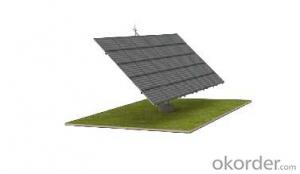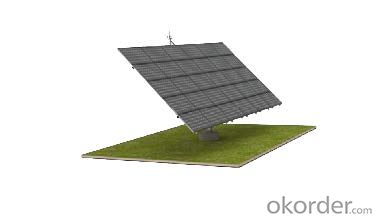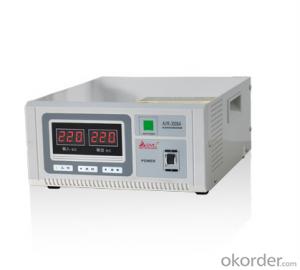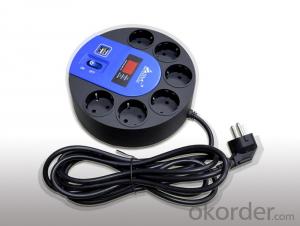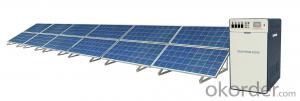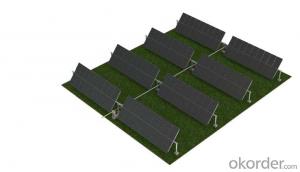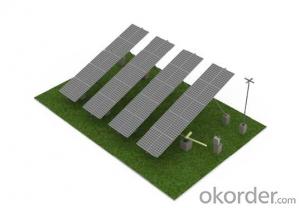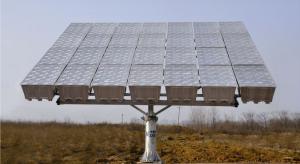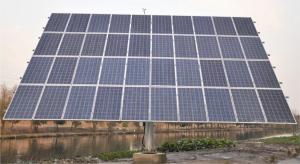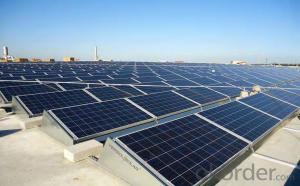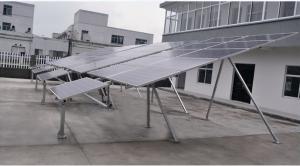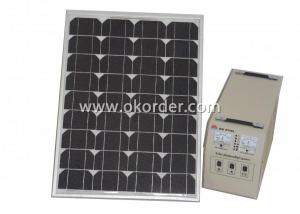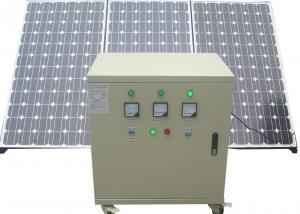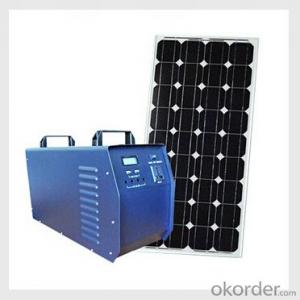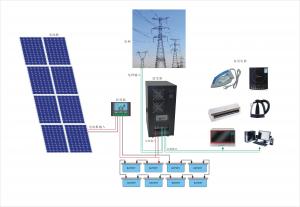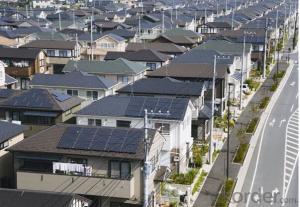My Life Solar Energy Systems Dual Axis Tracking System Solar Mounting System
- Loading Port:
- China Main Port
- Payment Terms:
- TT OR LC
- Min Order Qty:
- -
- Supply Capability:
- -
OKorder Service Pledge
OKorder Financial Service
You Might Also Like
Packaging & Delivery
Packaging Detail:Normal package seaworthy
Delivery Detail:15 days
Specifications
Easy installation Competitive price TUV&SGS test report & CSA certification 15-warranty
Specifications
1) Super smooth beautiful appearance,outstanding quality,large supply.
2) Available in customized surface finishes.
3) Well machined,for example,cutting,drilling and milling with excellent tolerance.
4) Meet with customer’s designs and supply you best price.
5)Usages:Supply for solar panel modules.
Technical characteristics
Installation site:
ground,hillside,and grassland
Installation angle
it is based on customers’ requirements
Installation height
it is basedon customers’ requirements
Solar panel type; with or without frame
Components arrangement :horizontal or vertical
Support track
aluminum alloy extrusion
Quality warranty
15 years
Advantages
1)Quick installation: with high degree of pre-installed rate, the system could be easily installed by using galvanized carbon steel rails for PV Stent, and specially designed connection parts of the PV bracket, which could reduce installation time and cost greatly.
2)Offer unmatched durability: with all structural components comprised of high class stainless steel and anodized aluminum alloy, it is designed for 25 years service life and backed by 15 years warranty.
3)Stand up to extreme weather: The SuninTek solar mount is designed to stand up to the extreme weather complied with the AS/NZ 1170 and other international structure load standard by the skilled engineer. The main support components also have been tested to guarantee its structure and load-carrying capacity.
4)Provide broad installation flexibility: These systems accommodate most commercially available framed solar panels , and they can scale easily from small to large, multi-megawatt installations.
5)Diversified Application: The PV mounting system produced can be adopted by various types of PV cells panels which you can find in the market. It can serve for both mini solar power system and huge plant with megawatt capability.
Main features
1. Installation cost savings.
2. Save installation time.
3. Increase the mechanical strength of solar energy mounting to ensure that wind requirements.
4. The outdoor for installation of solar energy.
5. Length can be customized according to customers.
6. Service life of up to 25 years.
7. Products through the international certification.
8. Stent material composition of the galvanized steel and aluminum.
9. 15 years system and structural guarantee.
10.Flexible post spacing withstands different wind & snow loads.
11. High quality material in Aluminium 6005-T5 and SUS 304.
12.Screws and nuts go with every components needed.
13.Mechanical calculation and reliability tested to ensure highest product quality.
- Q: How does the efficiency of solar panels vary with different weather conditions?
- The efficiency of solar panels can vary significantly depending on the weather conditions. Solar panels convert sunlight into electricity, and therefore, their efficiency is directly affected by the amount of sunlight they receive. On a clear and sunny day, solar panels operate at their peak efficiency since they receive the maximum amount of sunlight. The direct sunlight allows for optimal conversion of solar energy into electricity, resulting in higher efficiency. However, during cloudy or overcast days, the efficiency of solar panels decreases. This is because clouds block a significant portion of the sunlight, reducing the amount of energy available for conversion. While solar panels can still generate electricity under cloudy conditions, their efficiency is considerably lower compared to sunny days. Temperature is another weather factor that affects solar panel efficiency. Contrary to popular belief, solar panels actually work more efficiently in cooler temperatures. As the temperature increases, the performance of solar cells decreases due to a phenomenon called the temperature coefficient. High temperatures reduce the voltage output of solar panels, leading to lower efficiency. Rain or snowfall can also impact the efficiency of solar panels, although the effect is relatively minimal. Rain can temporarily decrease the efficiency by reducing the amount of sunlight reaching the panels, but once the rain stops, they return to their normal efficiency. Snow, on the other hand, can cover the panels and prevent sunlight from reaching them, resulting in a temporary loss of efficiency until the snow is cleared. In summary, the efficiency of solar panels varies with different weather conditions. Clear and sunny days provide optimal conditions for maximum efficiency, while cloudy or overcast days result in decreased efficiency. Temperature fluctuations can also impact the performance of solar panels, with higher temperatures leading to lower efficiency. Rain and snow can temporarily reduce efficiency, but their overall impact is relatively minor.
- Q: Are there any insurance considerations for solar energy systems?
- Yes, there are several insurance considerations for solar energy systems. First and foremost, it is important to ensure that the solar energy system is adequately insured against damage or loss. This typically involves obtaining property insurance coverage that specifically includes the solar panels and related equipment. Additionally, liability insurance is also crucial for solar energy systems. This type of insurance protects against any damages or injuries that may occur as a result of the solar energy system, such as a panel falling and causing property damage or personal injury. Liability coverage should be sufficient to cover potential risks and liabilities associated with the installation, operation, and maintenance of the system. It is also important to consider business interruption insurance. This type of coverage can provide financial protection in the event that the solar energy system becomes damaged or malfunctions, resulting in a loss of power production and revenue. Business interruption insurance can help to cover the costs of repairs, replacement equipment, and any lost income during the downtime. Finally, it is advisable to consult with an insurance professional who specializes in renewable energy systems to ensure that all potential risks and exposures are properly covered. They can assist in identifying any additional insurance considerations specific to the solar energy system and provide guidance on the appropriate types and levels of coverage needed to adequately protect the investment.
- Q: Can solar energy systems be used for powering breweries?
- Breweries can utilize solar energy systems to power their operations. Solar power, a renewable and sustainable energy source, offers a reliable and cost-effective solution for various industrial facilities, including breweries. By installing solar panels, breweries can generate electricity from sunlight to meet their energy needs. To run their equipment, breweries require a substantial amount of energy, including for boilers, refrigeration systems, pumps, and lighting. Solar energy systems can be tailored to meet these demands by sizing the solar panel array and incorporating energy storage systems like batteries, ensuring an uninterrupted power supply. The advantages of using solar energy in breweries are manifold. Firstly, it helps reduce energy costs by significantly decreasing or even eliminating electricity bills. This is particularly advantageous for breweries, as energy expenses can be a significant burden. By generating their own electricity, breweries can become more self-reliant and reduce their reliance on the grid. Secondly, solar power is an eco-friendly option. Breweries that transition to solar energy can significantly diminish their carbon footprint and minimize their impact on the environment. This can be a valuable selling point, as consumers increasingly prioritize sustainability and show support for businesses that embrace renewable energy. Moreover, solar energy systems require minimal maintenance and boast a long lifespan, making them a reliable and durable energy solution for breweries. With proper installation and regular monitoring, solar panels can last for 25-30 years or more, providing a stable and consistent energy source for breweries. In conclusion, solar energy systems are indeed suitable for powering breweries. They offer substantial cost savings, environmental benefits, and long-term energy reliability. As solar technology becomes more affordable and efficient, it is likely that more breweries will adopt this sustainable energy solution in the future.
- Q: Can solar energy systems be used for street lighting?
- Yes, solar energy systems can be used for street lighting. Solar-powered street lights are becoming increasingly popular as they offer a sustainable and cost-effective solution for outdoor lighting. These systems consist of solar panels that capture sunlight during the day and convert it into electricity, which is then stored in batteries. This stored energy is used to power the street lights during the night. Solar-powered street lights are not only environmentally friendly but also eliminate the need for extensive wiring and electricity consumption. They can be easily installed in remote locations where grid power is not available, making them a viable option for street lighting in both urban and rural areas. Additionally, solar-powered street lights offer the advantage of being independent from the main power grid, ensuring uninterrupted lighting even during power outages.
- Q: What is the role of solar energy systems in reducing greenhouse gas emissions?
- Solar energy systems play a crucial role in reducing greenhouse gas emissions by harnessing the power of the sun to generate electricity without any emissions. They provide a clean and renewable alternative to fossil fuels, such as coal and natural gas, which are major contributors to greenhouse gas emissions. By utilizing solar energy, we can significantly decrease our reliance on these polluting sources, leading to a substantial reduction in greenhouse gas emissions and helping combat climate change.
- Q: How do solar energy systems affect the installation of satellite dishes?
- Solar energy systems can potentially affect the installation of satellite dishes by obstructing the line of sight between the dish and the satellite. It is important to carefully plan and position both the solar panels and satellite dish to ensure they do not interfere with each other.
- Q: What is the impact of electromagnetic interference on the performance of solar panels?
- Solar panels can be significantly affected by electromagnetic interference (EMI). EMI refers to the disturbance caused by electromagnetic radiation from various sources like power lines, electronic devices, or radio waves. This interference can disrupt the normal functioning of solar panels and decrease their efficiency. The primary effect of EMI on solar panels is the degradation of the photovoltaic cells' ability to convert sunlight into electricity. When exposed to electromagnetic radiation, the cells can become less efficient in converting sunlight, resulting in less power generated. This directly impacts the overall output of a solar panel system and its ability to effectively meet energy demands. Furthermore, EMI can introduce electrical noise into the system, interfering with the required voltage and current levels needed for proper operation. This noise disrupts the control circuits and electronics within the solar panel system, leading to inaccurate measurements and potential malfunctions. In severe cases, excessive EMI can even damage the electronic components of the solar panel, further reducing its lifespan and performance. To minimize the impact of EMI on solar panels, several measures can be taken. Shielding techniques, such as using metallic enclosures or conductive coatings, can reduce the external electromagnetic radiation reaching the solar panels. Additionally, proper grounding and isolation of sensitive electronic components can minimize the interference caused by internal electrical noise. In conclusion, electromagnetic interference can significantly affect the performance of solar panels. It reduces conversion efficiency, introduces electrical noise, and can potentially damage electronic components. By implementing appropriate shielding and grounding measures, the negative effects of EMI can be mitigated, ensuring optimal performance and longevity of solar panel systems.
- Q: Can solar energy systems be used for powering electric vehicle solar charging parking lots?
- Yes, solar energy systems can definitely be used for powering electric vehicle solar charging parking lots. In fact, this combination of solar energy and electric vehicle charging is gaining popularity as a sustainable solution for transportation and energy needs. Solar panels can be installed on the parking lot structure or nearby rooftops to capture sunlight and convert it into electricity. This clean energy can then be used to power the electric vehicle charging stations located in the parking lot. By utilizing solar power, these charging stations can operate without relying on the grid, reducing the use of fossil fuels and minimizing greenhouse gas emissions. Additionally, solar-powered charging lots offer the advantage of being able to generate electricity during the day when the demand for charging is typically higher. This integration of solar energy systems and electric vehicle charging infrastructure is an innovative and environmentally friendly approach to powering transportation.
- Q: Are there any limitations to the amount of electricity a solar energy system can generate?
- Yes, there are limitations to the amount of electricity a solar energy system can generate. These limitations include factors such as the size and efficiency of the system, the amount of sunlight available, and the geographical location of the system. Additionally, external factors like weather conditions and shading can affect the system's performance and limit its electricity generation.
- Q: Can solar energy systems be used in areas with saltwater exposure?
- Yes, solar energy systems can be used in areas with saltwater exposure. However, it is important to consider the potential corrosion effects of saltwater on the system's components. Proper maintenance and the use of corrosion-resistant materials can help mitigate these effects and ensure the longevity and efficiency of the solar energy system in such areas.
Send your message to us
My Life Solar Energy Systems Dual Axis Tracking System Solar Mounting System
- Loading Port:
- China Main Port
- Payment Terms:
- TT OR LC
- Min Order Qty:
- -
- Supply Capability:
- -
OKorder Service Pledge
OKorder Financial Service
Similar products
Hot products
Hot Searches
Related keywords
